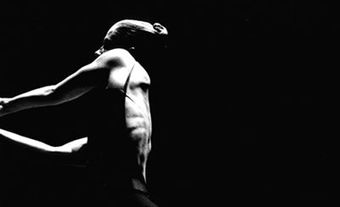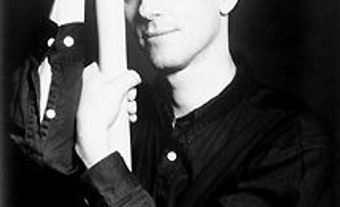This article was originally published in Maclean's Magazine on January 16, 1995

Levine, Michael (Profile)
A frame tiled with lustrous gold leaf surrounds the dark stage. The string section plays the sustained opening notes, which are as weighty and light-smothering as black velvet. Onstage, a revolving, glistening miniature castle emerges from the obscurity. Designed by Michael Levine, the Canadian Opera Company (COC) production of Béla Bartók's one-act 1911 work, Bluebeard's Castle, begins to exert its dark spell even before the torturing, tortured Bluebeard ushers his latest child bride into his windowless castle. "I'm interested in storytelling, and I'm interested in collaboration," Toronto-based Levine, arguably the country's hottest stage designer, said in a recent interview. What he is not interested in is design that calls attention to itself without enhancing and clarifying the story. When the text, the music, the sets and all the other aspects of a production come together, Levine gets what he really wants: something, he says, that will "intrigue, shock and excite people."
Toronto's COC ended up with precisely that when it hired innovative Quebec director Robert Lepage and Levine to create its double bill of Bluebeard's Castle and Arnold Schoenberg's Erwartung (Expectation), a half-hour 1909 work for solo soprano. Premièred in Toronto in 1993, the double bill went on to receive great acclaim in New York City, at the 1993 Edinburgh International Festival and at the Melbourne International Festival in Australia last October. This week, Bluebeard's Castle and Erwartung return to Toronto's O'Keefe Centre for a seven-performance run.
Levine, 34, has already designed sets and costumes for several major opera companies in Europe and North America. Currently, he is working with his frequent collaborator, London-based Canadian director Robert Carsen, on productions of two early operas by Giuseppe Verdi: Nabucco, for the Opéra Bastille in Paris, and Jerusalem, for the Vienna State Opera. The Bluebeard's Castle-Erwartung pairing, which will travel to Geneva in March, is one of five Levine-designed productions that will be remounted this year.
As well, Levine was the production designer on September Songs, a film made by Toronto's Rhombus Media in partnership with ZDF/German Television. Featuring Kurt Weill compositions performed by musicians ranging from Teresa Stratas to Lou Reed and Elvis Costello, it will be shown on PBS stations on Jan. 25 and on the CBC later this year.
When Levine was a teenager at the Ontario College of Art in his native Toronto, he found that he loved creating sets and costumes for student productions. At the age of 19, he left Canada to attend London's Central School of Art and Design. Three years later, he landed a job at the inventive, low-budget Glasgow Citizen Theatre. "We were all working on top of each other, 24 hours a day, and having a fantastic time," he recalls with a grin. By the mid-1980s, he was back in Ontario, winning rave reviews for his work at the Shaw Festival and with the Canadian Stage Company.
One of his most rewarding creative partnerships began when he collaborated on the 1989 theatre piece Tectonic Plates with its writer, Robert Lepage. "What I like about his work," Lepage says of Levine, "is that in the process of working on a production he comes up with many different ideas for sets, and then they all end up in one simple, strong idea. Most designers want things to look good, but he wants things to work."
When Lepage and Levine staged A Midsummer Night's Dream for London's Royal National Theatre in 1992, they daringly lifted Shakespeare's fanciful romantic comedy out of its enchanted forest and plopped it down in a muddy pond. Front-row spectators were provided with protective plastic ponchos."We talked about how scary it is to be lost in the woods at night," says Levine. "You're falling and you're getting wet and you're bleeding, and a lot of those things are connected very much with our fears about sex. All of that is connected to A Midsummer Night's Dream." Critics called the production everything from "a travesty of the play" to "brilliantly imaginative."
For what the COC has called its "blood-red double bill," Lepage, Levine and lighting designer Robert Thomson created productions that are at once stark and visually stunning. In the Bartók opera, Bluebeard (Victor Braun) reluctantly lets his new bride, Judith (Jane Gilbert) unlock the chambers of his castle. Each opened door reveals some terrible secret. Levine leaves those horrors to the audience's imagination - as the doors are opened, different types of light flood into the castle. In Erwartung, meanwhile, an apparently insane woman (Rebecca Blankenship) recounts, in song, a disjointed story of murder and betrayal. The surreal staging includes arms emerging from a solid wall and a note-taking psychologist perched in mid-air at an impossible angle.
Those designs were created in the tidy, reference-book-lined studio in Toronto's garment district that Levine calls home. His busy international career keeps him away for months at a time, working on such projects as Jerusalem, which opens in Vienna in December. In the studio, Levine is working on a marvellously intricate scale model for the opera. Bending a goosenecked lamp close to the model's slatted side, he demonstrates how the lighting will add drama to the entrance of Crusader knights in sparkling armor. Watching him, it is clear that for Michael Levine, design and content are truly inseparable.
Maclean's January 16, 1995

 Share on Facebook
Share on Facebook Share on X
Share on X Share by Email
Share by Email Share on Google Classroom
Share on Google Classroom


